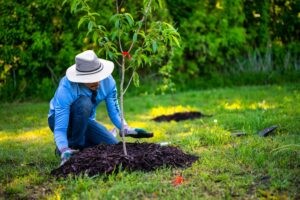By: Abby Krause, Western Region Urban Forestry Coordinator, Abigail.Krause@wisconsin.gov
Hoping to avoid the repeated destruction from Dutch elm disease (DED) and emerald ash borer (EAB), a new wave of planting initiatives focuses on species diversity. However, acquiring species to meet these diversity goals is often easier said than done. Below are some tips based on comments and feedback from nurseries and other tree managers to help your tree ordering process go smoother in the future.
- Know B&B (Balled and Burlapped) seasonality. Some species are harvested from the fields in spring only because they do not tolerate having their roots disturbed later in the season. If these species sell out at the beginning of the year, they will not be available again until the following year. Prioritize B&B spring dug species for spring orders or check the availability of container-grown stock for later in the year. Your nursery supplier will be able to elaborate on which of their offerings are exclusively spring dug.
- Specify (spec) by caliper and not DBH. Both are measures of tree diameter, so what’s the difference? Caliper is predominantly measured at 6 inches above the soil, while DBH (diameter at breast height) is measured at 4.5 feet. While DBH is used in other parts of urban forestry (think inventories, wood volume, etc.), caliper is the go-to when referring to nursery stock. You may have difficulty finding large enough stock if you’re using DBH by mistake.
- Don’t specify species included in NR 40 (the invasive species rule). First, you don’t want to use species that can become problematic in the natural areas of your community. Secondly, some nurseries cannot bid on proposals that include invasive species because of their company procedures and will end up rejecting your entire proposal.
- Be flexible (but firm) on species substitutions. What was the main reason behind your original species selection: Do they handle tough soil conditions, maximize stormwater interception, and provide wildlife habitat? Will another species accomplish the same primary goal? Keep in mind the 5-10-15 Diversity Rule. Your urban tree population should include no more than 5% of any one species, 10% of any one genus, and 15% of any one family. Knowing why a tree was selected will allow you to make an informed decision on potential substitutions and prevent you from planting an unsuitable tree for the site simply because it was the only thing available.
- Be flexible on stock size. Nurseries noted that people tend to prefer 1.75-2.00” caliper stock. Will a slightly smaller or larger stock size work for your planting site? Smaller trees can be easier to work with and additionally establish and start putting on new growth faster. Larger trees need a longer water maintenance plan, but their size can help deter vandalism in high-traffic areas and add instant aesthetics.

Credit: Alfo Medeiros, Pexels
- Seedlings in natural areas. Response to storms/pests/disease, stormwater mitigation, and the addition of no-mow areas are a few instances that may spur planting in community natural areas. Using bare root seedlings often makes the most financial and logistical sense in these instances. Natural areas also offer locations to plant trees that may be less desirable along roads and trails but still help increase the community’s overall species diversity. Native seedlings are available each spring from private nurseries and the DNR nursery, with orders typically opening each October for spring delivery.
- When in doubt, call and ask. Calling nurseries to ask about their species availability for the upcoming season and future years can help plan your planting projects. Trees need time to grow to reach their salable size. When a species you’re interested in is not readily available, inquire if it’s currently being grown and when it will be ready for purchase. If it’s not being grown, let the nursery know it’s a species you’d be interested in acquiring in the future. The 2020 Diverse Urban Tree Species Survey results highlight the availability and success rate of lesser-used species in Wisconsin communities.
- Let nurseries know if you’re open to trying new species. While chatting with your local nurseries about the species you’d like to see available, make them aware if you’re also open to trying new species. Nurseries are interested in the performance of new species in the landscape before they scale up production. The City of Stevens Point’s Forestry Department tests new species in a local park before using them
- Contract grows for known upcoming projects. Most municipalities don’t meet the minimum quantity requirements for contract grows with their regular annual plantings. However, it may be viable for projects like a new park or major street redevelopment. Exploring the feasibility of splitting a contract grow with a neighboring community may be another way to meet the minimum thresholds.
- Don’t wait to order. Lastly, a simple tip but perhaps the most important of them all: For the best-guaranteed selection, plan on having your trees ordered they will be going in the ground. The earlier, the better if there are specific species and sizes needed. With the high demand for trees, some communities even order trees in the fall for their spring planting season.
(Visited 889 times, 1 visits today)
